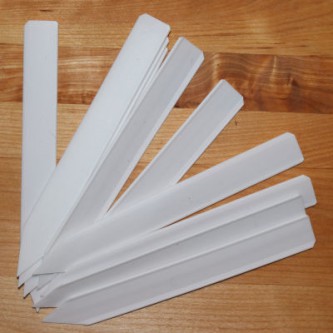Hot Pepper Buena Mulata is a very beautiful, distinctive and unusual pepper variety. Buena Mulata translates as “beautiful colour”, which is certainly true in this case. The unripe peppers ripen from purple to pinkish red and brownish orange to bright red. The stems and calyx of this plant are also purple at first. This makes the plant very decorative. This hot pepper was introduced by food historian William Woys Weaver from his grandfather's collection. His grandfather received this hot pepper in 1944 from Horace Pippin, the African-American artist. These hot peppers grow to a length of 6-8 cm. The thickness of these hot peppers varies between 2 and 2.2 cm. The fresh fruits weigh an average of 10 grams with the stem still attached. They also closely resemble Cayenne peppers. These hot peppers are about as hot as a Cayenne. The colour of the unripe hot peppers is the most beautiful thing about Buena Mulata peppers. The moderately spicy flesh is light green in colour. Just like Cayenne peppers, these hot peppers can also be used at all stages. This hot pepper can be used both fresh and dried. It can also be ground very well into powder or flakes. The stems of this plant are beautifully purple striped. The flowers are white and purple striped. This decorative plant can also be grown indoors in a large pot. This plant produces a medium-early, good harvest.
Chilli peppers are the fruits of the hot pepper plant. They are related to the pepper. Pepper originates from Central America and South America. It was spread all over the world by the Spanish, Portuguese and Dutch. They grow best under sufficient heat. In the living room or in an unheated greenhouse in our climate (the Netherlands). Another name for chilli pepper is hot pepper, red pepper, Spanish pepper and Lombok. Chillies come in many different sizes and colours. For example big, small, red, yellow, white, purple, brown, orange and green. Chillies can be eaten fresh, dried, in powder or as flakes. You can dry chillies yourself by hanging them upside down in a dry, warm and well ventilated room or by drying them in a very lukewarm oven (70 °C) and in a special drying cabinet. Pepper powder is also called cayenne powder and chilli powder. Chillies contain many healthy nutrients such as capsicum, capsaicin, bioflavonoids, vitamins and minerals. Capsicum is also used in medicines to treat, for example, a runny nose and colds. Capsaicin is the substance in peppers that makes them so pungent. Pepper also helps to prevent diseases such as colds, arteriosclerosis, heart disease and inflammation. Pepper also has an analgesic effect, gives a feeling of happiness, helps against sinusitis, colds, inflammations, cardiovascular diseases, arteriosclerosis and against cold feet in the winter.
Pepper is very healthy and versatile. It contains, among others, the vitamins: A, B1, B2, B3, B5, B6, C, E and K. And the minerals: phosphorus, iron, potassium, copper, manganese and magnesium. It also contains many antioxidants such as: alpha-carotene, beta-carotene, cryptoxanthins, lutein and zeaxanthin. You can boil, steam, stew, grill, bake, use in oven dishes, in stews, add finely chopped to salads and raw vegetables, barbeque, wok and add to Indonesian, Mexican, Italian, Spanish, Moroccan and other dishes. You can also make sambal, chilli jam and chilli sauce from chillies. You can also add chillies to sauces, soups and other dishes which can use some spice. Chillies also contain carbohydrates, protein, fibre and few calories. Chillies are delicious in combination with: minced meat, beef, pork, chicken, lamb, chocolate, cocoa, rice, noodles, pasta, olive oil, ginger, soy sauce, cumin, coriander, chives, basil, thyme, rosemary, paprika, butter, apple, curry, parsley, red wine vinegar, white wine vinegar, balsamic vinegar, cheese, Parmesan cheese, mustard, coconut milk, milk, tomato puree, oregano, red wine, cinnamon sticks, gingerbread, apple syrup, lemon and lime. And with vegetables such as: leeks, onions, garlic, peppers, tomatoes, potatoes, carrots, cauliflower, kale, Brussels sprouts, broccoli, spring onions, shallots, lentils, chickpeas, green beans, snow peas, red cabbage, cucumber, mushrooms, pointed cabbage, white cabbage, kidney beans, brown beans, bean sprouts and lettuce. Be careful not to eat too many hot peppers. It can cause stomach problems such as heartburn. Also, after cleaning and cutting hot peppers, do not touch your eyes with your hands. Chili peppers can also help you lose weight. Hot food is more likely to make you feel full. And chilli gives your metabolism a boost. Hot food makes you feel hot and this speeds up your metabolism. As a result, you burn more calories. Fresh red peppers can be kept in the vegetable compartment of the fridge for 5-7 days. You can also keep peppers in a glass jar filled with olive oil. In this way, the peppers can be kept for months (5 - 6). You can also freeze them. Cut the stalks from the chillies. Wash them well and freeze them whole, in this way you can keep them for about 12 months. Non hardy perennial. Height: 60 cm. Scoville units: 30.000 - 50.000.









